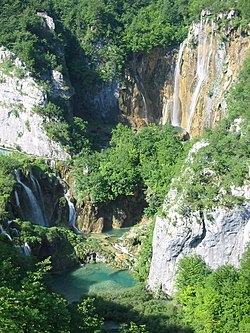| Plitvice Lakes National Park | |
|---|---|
| Nacionalni park Plitvička jezera (Croatian) | |
 | |
 | |
| Location | Lika-Senj County, Karlovac County, Croatia |
| Coordinates | 44°52′50″N 15°36′58″E / 44.88056°N 15.61611°E |
| Area | 296.85 km2 |
| Elevation | 367 m (Korana bridge), 1279 m (Seliški vrh) |
| Visitors | 1,367,304[1] (in 2015) |
| Governing body | Javna ustanova Nacionalni park Plitvička jezera HR-53231 Plitvička jezera Tel. +385 (0)53 751 015 www.np-plitvicka-jezera.hr |
| Type | Natural |
| Criteria | vii, viii, ix |
| Designated | 1979 (3rd Session) |
| Reference no. | 98 |
| Extensions | 2000 |
| Endangered | 1992–1997 |
IUCN Category II (National Park) | |
| Type | Natural |
| Designated | 1979 |
| Official name | Nacionalni park Plitvička jezera |
| Designated | April 8, 1949 |


Plitvice Lakes National Park (Croatian: Nacionalni park Plitvička jezera, colloquially Plitvice, pronounced [plîtʋitse]) is one of the oldest and largest national parks in Croatia.[2] In 1979, Plitvice Lakes National Park was inscribed on the UNESCO World Heritage list, for its outstanding and picturesque series of tufa lakes, caves, and connected waterfalls.[3]
The national park was founded in 1949 and is in the mountainous karst area of central Croatia, at the border to Bosnia and Herzegovina. The important north–south road that passes through the national park area connects the Croatian inland with the Adriatic coastal region.
The protected area extends over 296.85 square kilometres (73,350 acres). About 90% of this area is part of Lika-Senj County, while the remaining 10% is part of Karlovac County.
Each year, more than 1 million visitors are recorded,[4][1] making the national park the most popular tourist attraction in Croatia.[5] Entrance is subject to variable charges, between 10 and 40 € per adult per day in summer (as of 2024[update]).[6]
- ^ a b Cite error: The named reference
indexwas invoked but never defined (see the help page). - ^ There are seven other national parks in Croatia, as well as ten nature parks.
- ^ "Plitvice Lakes National Park". UNESCO World Heritage Centre. United Nations Educational, Scientific, and Cultural Organization. Retrieved 22 May 2021.
- ^ Cite error: The named reference
record_visitwas invoked but never defined (see the help page). - ^ "Plitvice Lakes: the Ultimate Guide to Visiting (2023)". The World Is A Playground. 12 May 2019. Retrieved 17 November 2023.
- ^ "Price list - Nacionalni park "Plitvička jezera"". np-plitvicka-jezera.hr. Retrieved 2024-04-24.

